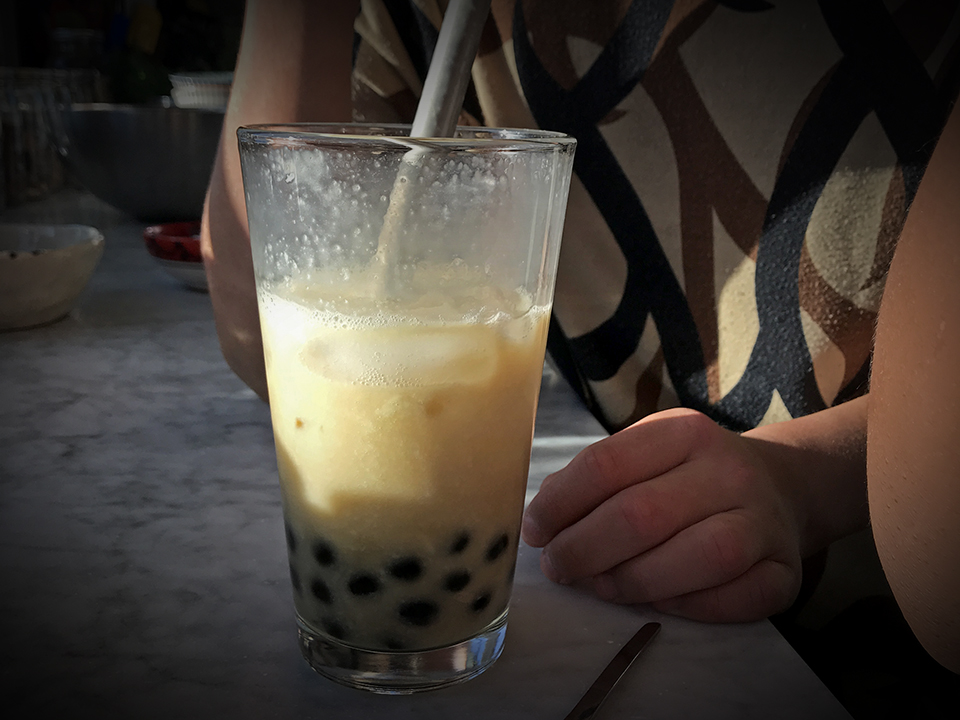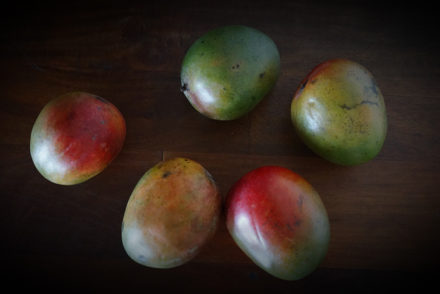& The Perfect Amount of QQ
Bubble Tea is a Taiwanese invention said to have originated in the 80’s at a well-known tea stand. Randomly some flavor was shaken into tea, the bubbles that formed with the shake essentially named the drink. Milk tea was already quite common, so adding sweet flavors become new way to enjoy it. Tapioca pearls came next, which had just been introduced to Taiwan and were heavily used in desserts and sweet delicacies. It was only a matter of time before they made their way into the sweet, dessert-like milk tea concoction.
The chewy texture of the tapioca pearls, which are made from the starch of the cassava root, is the best part of a bubble tea. Achieving the perfect QQ is not easy. QQ , I learned, is a Chinese word for perfectly chewy or exactly the right amount of aldente. I learned the secret formula to making perfect QQ is time and patience.
I learned a lot in researching the history of bubble tea; which I often had hear referred to as boba tea. I learned the word BOBA is Chinese slang (used in Taiwan) for large breasts. Although many recipes refer to the drink as BOBA Tea, I will not be and hope that the reference dissipates as people learn what it means, as it doesn’t seem appropriate once you know. I tend to roll with the words of Maya Angelou engrained in my head, “ once you know better you do better.” May father always said a version of that as well, only his version wasn’t as poetic.
Along with the details behind the term I also learned that I most likely use the term bubble tea vs boba, because it’s an east coast west coast thing and luckily I lived in Brooklyn for 13 years. So even though I live in California now, I (thankfully) say bubble tea and not boba. I don’t say dude either, thankfully.
I don’t drink bubble tea and never sought it out. But it has always proven to be a fun and attention getting recipe in my kids classes and I find it an easy way to incorporate fresh fruit items in a drink. A drink that’s not too sweet that also gives me the opportunity to give a little education on culture and how culture spreads. I didn’t tell the middle schoolers in this week’s class what boba meant, but I contemplated it, hoping that if they knew they might not saw it, in the end I opted against it, as I didn’t want to be the one to teach them the Chinese slang for big boobs.
Adding fresh mango, using coconut milk and local honey, as I do in my version, takes what normally tastes like a fake processed sugar drink, more tropical, lighter and more naturally refreshing, which is also how I describe a good iced milk tea. I prefer using earl grey tea in my version, which seems lighter and therefore contributes to greater refreshing qualities, not to mention the slightly perfumed essence of the earl grey mingles perfectly with mangoes and encourages their perfumed qualities to pop, which for me is a mangoes most heavenly flavor characteristic.
This recipe empowers the essence and potency of each ingredient individually while showcasing how they play and complement and intermingle with each other perfectly. The outcome is a really tasty tropical and exotic drink that’s super refreshing with something to chew on, which adds a fun quality……
QQ Perfect Fresh Mango Coconut Bubble Tea
Makes 6 drinks
My version is less sweet than the average bubble tea, but more rewarding in terms of natural fresh flavors. You can use any black tea and milk of choice; coconut, almond, oat, regular.
Ingredients
¾ cup black tapioca pearls
8-10 cups water
1 ½ cup Mango Pit Honey Nectar *Recipe below
1 fresh, ripe mango, cubed
1 can coconut milk
1 cup water
3 cups earl grey tea, steeped strong, room temperature
Directions
Make the Mango Pit Honey Nectar * Recipe Below
Cook the tapioca pearls by bringing water to a boil. (Always use at least 8 times as much water as there are tapioca pearls for best results.) Gently add the tapioca pearls and cook for about 25 minutes on a medium high- gently rolling boil. Strain the tapioca and add them to 1 cup of Mango Pit Honey Nectar in a medium mixing bowl. Stir gently, making sure the tapioca pearls get smothered in the nectar. Let rest for 30 minutes, unrefrigerated.
Combine the fresh mango, the remaining ½ cup mango nectar, the coconut milk and water in a blender and blend until totally smooth and all ingredients are blended together. This mixture can be chilled and refrigerated no longer than 10 days for optimal flavor and freshness.
To prepare drinks.
Place about ¼ – 2/3 cup of cooked tapioca pearls with nectar in a large glass (wide mouthed glasses are best) and pour about ½ cup steeped tea over the top, followed by about ¾ cup of the mango coconut mixture. Add a few ice cubes and stir. Use a wide (sustainable) straw or a spoon to get to the chewy tapioca!
Mango-Pit Honey Nectar
Makes 3 cups of nectar
Ingredients
2-3 mango pits, ideally with some flesh left on them
2 ½ cups water
½ cup honey
¼ cup mango puree
Directions
Combine the mango pits and the water in a medium sauce pan and bring to a boil. Reduce temperature and simmer for about 10 minutes. Take of the stove and remove and discard mango pits. Whisk in honey and mango puree. Cool completely and them refrigerate.
This can be refrigerated for up to two weeks. Use it to sweeten iced or hot tea, lemonade, cakes, desserts, smoothies etc!











No Comments